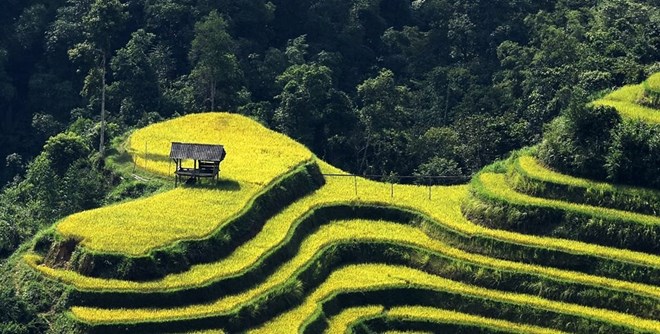
A cultural and tourism festival promoting the beauty of Hoang Su Phi’s terraced fields and ethnic culture is due to kick off in the northern mountainous province of Ha Giang on September 28.

The harvest season in Hoang Su Phi falls in September and October,
creating a breathtaking scene that attracts tourists to Ha Giang province every
autumn (Photo: VNA)
According to Vu Manh Ha, Secretary of Party Committee of Hoang Su Phi district,
the three-day event will include trade fairs introducing local specialties,
embroidery, weaving and cooking competitions for the La Chi group in Ban Phung
commune; ritual ceremonies of the Dao group in Ho Thau commune; and typical
festivals of the Mong group.
Visitors will be able to visit an ancient tea forest in Nam Pien commune, join
traditional dances with the Dao and Nung ethnic groups or go sightseeing at the
waterfall in Thuong village.
An indispensable part of the journey will be the golden Hoang Su Phi terraced
fields viewed from Nam Ty or San San Ho communes.
The harvest season in Hoang Su Phi falls in September and October, creating a
breathtaking scene that attracts tourists to Ha Giang province every autumn.
On November 1, 2011, the Ministry of Culture, Sports and Tourism recognised 760
hectares of Hoang Su Phi terraced fields located across six communes in the province
as a national heritage.
Source: VNA
The People’s Committee of Lac Son district held a ceremony on April 28 to receive the provincial relic certificate for the ancient rock carving site at Suoi Co stream, located in My Thanh commune.
A special music show titled "The country is in the fullness of joy” has been held at Hoa Binh Square in Hoa Binh city in celebration of the 50th anniversary of the liberation of the South and national reunification (April 30, 1975–2025).
The People's Committee of Lo Son commune, Tan Lac district, has organised the local annual traditional stream fishing festival on April 19 - 20.
As a land deeply intertwined with human history and Vietnam’s millennia-long journey of nation-building and defence, Hoa Binh is often revered for its epic tales and legends.
Residents of Hoa Binh boast a rich cultural identity, reflected in their unique language, traditional attire, customs, and folk melodies – described as "sweet as honey, clear as a mountain stream.”
Lac Son district’s Vu ban town held the 2025 Truong Kha temple festival on April 12–13 (the 15th–16th days of the third lunar month). Since its revival in 2019, the festival has been organised every three years, preserving valuable intangible heritage while meeting the community’s cultural and spiritual needs.



